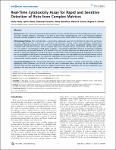Real-time cytotoxicity assay for rapid and sensitive detection of ricin from complex matrices.
Pauly, Diana
Worbs, Sylvia
Kirchner, Sebastian
Shatohina, Olena
Dorner, Martin
Dorner, Brigitte
Background: In the context of a potential bioterrorist attack sensitive and fast detection of functionally active toxins such as ricin from complex matrices is necessary to be able to start timely countermeasures. One of the functional detection methods currently available for ricin is the endpoint cytotoxicity assay, which suffers from a number of technical deficits. Methodology/Findings: This work describes a novel online cytotoxicity assay for the detection of active ricin and Ricinus communis agglutinin, that is based on a real-time cell electronic sensing system and impedance measurement. Characteristic growth parameters of Vero cells were monitored online and used as standardized viability control. Upon incubation with toxin the cell status and the cytotoxic effect were visualized using a characteristic cell index–time profile. For ricin, tested in concentrations of 0.06 ng/mL or above, a concentration-dependent decrease of cell index correlating with cytotoxicity was recorded between 3.5 h and 60 h. For ricin, sensitive detection was determined after 24 h, with an IC50 of 0.4 ng/mL (for agglutinin, an IC50 of 30 ng/mL was observed). Using functionally blocking antibodies, the specificity for ricin and agglutinin was shown. For detection from complex matrices, ricin was spiked into several food matrices, and an IC50 ranging from 5.6 to 200 ng/mL was observed. Additionally, the assay proved to be useful in detecting active ricin in environmental sample materials, as shown for organic fertilizer containing R. communis material. Conclusions/Significance: The cell-electrode impedance measurement provides a sensitive online detection method for biologically active cytotoxins such as ricin. As the cell status is monitored online, the assay can be standardized more efficiently than previous approaches based on endpoint measurement. More importantly, the real-time cytotoxicity assay provides a fast and easy tool to detect active ricin in complex sample matrices.
Dateien zu dieser Publikation
Keine Lizenzangabe

